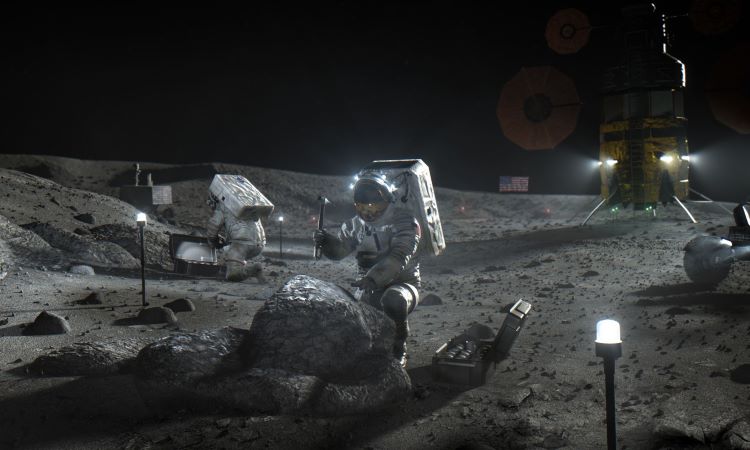SOS from Space: How Astronauts Would Call for Help from the Moon
Exploring the Moon presents immense challenges, not just in terms of survival but also in ensuring timely rescue during emergencies. To address these challenges, Australian researchers have proposed a novel lunar distress system based on COSPAS-SARSAT technology. This groundbreaking approach uses low-power emergency beacons and a satellite network to ensure communication, location tracking, and coordination for lunar rescue missions. The solution not only enhances astronaut safety but also holds the potential to improve emergency systems on Earth.
Summary
- The Need for a Lunar Distress System: The Moon’s harsh environment demands robust emergency solutions for astronauts.
- Technology Inspiration: Researchers adapted the Earth-based COSPAS-SARSAT system for lunar use.
- Low-Power Emergency Beacons: These beacons are lightweight and require minimal setup.
- Satellite Constellation: A network of small satellites will enable communication and navigation for rescue operations.
- Integration with Artemis Program: The system aligns with NASA’s Artemis objectives of sustained human presence on the Moon.
- Collaborative Efforts: Scientists from Australia and the United States are spearheading the project.
- Impact Beyond the Moon: This innovation could also transform emergency responses in remote Earth locations.
- Battery Longevity: Emergency beacons will last significantly longer than conventional solutions.
- Firsts for Artemis: The Artemis missions will include diverse astronauts, emphasizing inclusivity in space exploration.
- Lunar Environment Challenges: Craters, mountainous regions, and extreme temperatures create unique rescue challenges.

Main Article
The Moon’s environment is nothing short of extreme. Unlike Earth, it lacks an atmosphere, leaving astronauts exposed to harmful radiation, micrometeorites, and temperature extremes. Even minor accidents in this hostile environment could prove fatal without a reliable rescue system.
Researchers identified this gap as they prepared for NASA’s Artemis program, which plans to establish a sustained human presence on the Moon by the mid-2020s. One significant challenge was ensuring astronauts could call for help in emergencies when traditional Earth-based communication systems may fail.
𝑇𝑒𝑐ℎ𝑛𝑜𝑙𝑜𝑔𝑦 𝐼𝑛𝑠𝑝𝑖𝑟𝑎𝑡𝑖𝑜𝑛: 𝐶𝑂𝑆𝑃𝐴𝑆-𝑆𝐴𝑅𝑆𝐴𝑇
The COSPAS-SARSAT system, used globally for search and rescue operations, served as inspiration. This Earth-based system has been saving lives for decades using satellites to track distress signals from beacons on land, sea, and air. By adapting this technology for lunar missions, researchers could overcome the Moon’s communication challenges.
𝑇ℎ𝑒 𝐸𝑚𝑒𝑟𝑔𝑒𝑛𝑐𝑦 𝐵𝑒𝑎𝑐𝑜𝑛𝑠: 𝑆𝑚𝑎𝑟𝑡 𝑎𝑛𝑑 𝐸𝑓𝑓𝑖𝑐𝑖𝑒𝑛𝑡
Emergency beacons developed for this project are lightweight and durable, designed for easy activation by astronauts. They operate on low power, ensuring longer battery life—a critical requirement in remote lunar locations where rescues could take days.
Table 1: Features of Lunar Emergency Beacons
| Feature | Description | Impact |
|---|---|---|
| Low Power | Operates on minimal energy | Prolonged usability |
| Lightweight Design | Easy for astronauts to carry | Reduces mission payload |
| Durable Build | Resistant to lunar conditions | Ensures reliability |
The project envisions a constellation of small satellites orbiting the Moon. These satellites will relay emergency signals from astronauts to Earth or nearby lunar stations. This approach ensures that even astronauts in deep craters or behind mountainous terrain can communicate effectively.
Table 2: Lunar Satellite Network vs. Traditional Communication
| Aspect | Lunar Satellite Network | Traditional Communication |
|---|---|---|
| Coverage | Comprehensive lunar surface | Limited |
| Real-Time Tracking | Yes | No |
| Resilience in Terrain | High | Low |
The technology developed for the Moon can revolutionize search and rescue operations on Earth. In regions where mobile signals are unreliable, these beacons could provide a lifeline during disasters such as earthquakes or floods.

NASA’s Artemis program has ambitious goals: returning humans to the Moon, establishing a base camp, and preparing for Mars exploration. The lunar distress system seamlessly aligns with these objectives, ensuring astronaut safety as they navigate uncharted territories.
Artemis I successfully tested the Orion spacecraft in 2022, setting the stage for future crewed missions. Artemis II will follow in 2025, with astronauts venturing to the Moon’s surface. This rescue technology will play a pivotal role in ensuring their safety.
The University of South Australia and American partners have been at the forefront of this initiative. The Australian government allocated $100,000 to support the development of the Lunar Search and Rescue (LSAR) system. This collaboration is expected to elevate Australia’s role in global space exploration efforts.
𝐶ℎ𝑎𝑙𝑙𝑒𝑛𝑔𝑒𝑠 𝐴ℎ𝑒𝑎𝑑
Despite its promise, the lunar distress system faces challenges, including:
- High Costs: Developing and deploying satellites is expensive.
- Harsh Lunar Conditions: The Moon’s extreme temperatures and radiation levels could affect system durability.
- Long-Distance Communication: Ensuring low-latency signal transmission over 384,400 km.
The lunar distress system represents a significant leap in ensuring astronaut safety on the Moon. By adapting proven Earth-based technology, researchers have created a solution that addresses the unique challenges of lunar exploration. This innovation not only advances the Artemis program but also offers practical applications on Earth, reinforcing the interconnectedness of space and terrestrial advancements.
References
- University of South Australia: Lunar Distress System
- NASA Artemis Program
- COSPAS-SARSAT Official Site
- Safety from Space Initiatives



